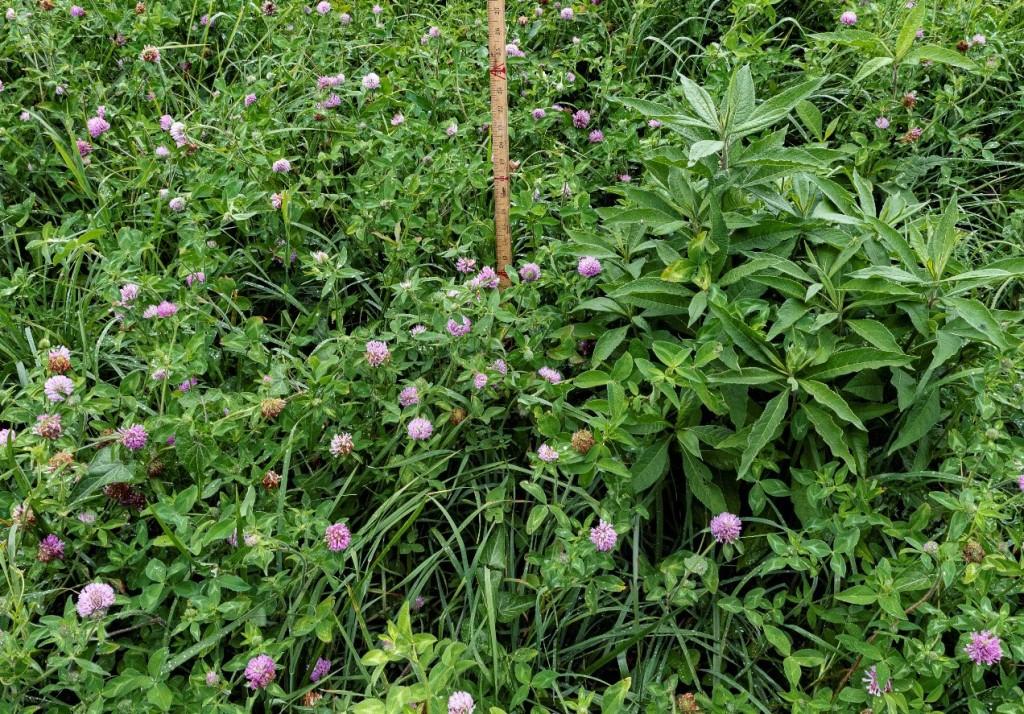To Spray or Not To Spray?

Here are some guidelines that help me formulate a weed control plan. I will be the first to admit this is a highly subjective set of guidelines or suggestions.
Would you spray the field pictured above? Tough question to weigh the value of a good stand of vigorous red clover (18 inches tall) compared to freedom from ironweed (24 inches tall). The decision to spray is a subjective process depending on many factors, including weed pressure, invasiveness and/or toxicity of the weed, cost of the control measure, forage value of the weed and its life cycle and the ability to restore the pasture stand.
Non-chemical control
Farmers have other options besides spraying herbicide. Sometimes the best approach is to use cultural practices or grazing management to strengthen the forage crop and deal with the weed. Ragweed and some thistles are common examples. The UK publication AGR 207 ‘Controlling Broadleaf Weeds in Kentucky Pastures’ evaluates the effectiveness of mowing as a weed management tool for many of our problem pasture weeds.
The Clover Dilemma
A vigorous stand of red clover would be worth protecting in all but the worst weed infestations. A stand of small, white dutch clover, probably not. And remember that some new herbicide formulations will take out broadleaves without killing clover. Proclova ® is one example.
Annuals
With annual weeds, it is usually best to first try to thicken up the forage stand. Annuals are opportunistic; they germinate and grow when forage stands get sparse. Addressing lime, P and K needs and strategic use of nitrogen fertilizer are some of the most powerful tools to shift the advantage to the desirable forage. Implementing rotational grazing and maintaining good residual heights on the base grass will help suppress the onset of these weeds.
Toxic and invasive plants
Toxic and invasive weeds will often necessitate the use of herbicides. The cost/benefit ratio of using chemical control is influenced greatly by the threat of loss of livestock and the loss of value due to their presence in hay.
Cash hay vs pasture
Some weeds can be tolerated or even be beneficial in pasture that would warrant herbicide application in a cash hay crop. For example, johnsongrass and crabgrass are highly palatable forages that benefit summer pastures but are not welcome in hay intended for high end horse markets.
Weed growth stage matters
Weeds are most easily controlled when they are green and actively growing. For perennials like ironweed, time herbicide applications so that plants are young and vegetative. Often that means timely mowing in mid-summer to knock them back and following up with herbicide in two or three weeks.
Replant strategy
A plan to spray almost always requires a plan to replant because when the weed is gone, mother nature will insert another one. Refer to the label for the proper re-seeding interval.
The decision to spray herbicide on pastures and hayfields is complicated. The decision to spray is a subjective process depending on many factors, including the visual assessment of the weed pressure, the invasiveness and/or toxicity of the weed, the cost of the control measure, the forage value of the weed and its life cycle and the ability to restore the pasture stand. Don’t forget that the best first step is to thicken up the existing stand of forage. Happy foraging.
Jimmy Henning, PhD, extension forage specialist in UK’s Department of Plant and Soil Sciences provided this information. Source: Aug. 31, Kentucky Forage News excerpt of Farmer’s Pride story. Subscribe to The Farmer’s Pride to read the full article.
